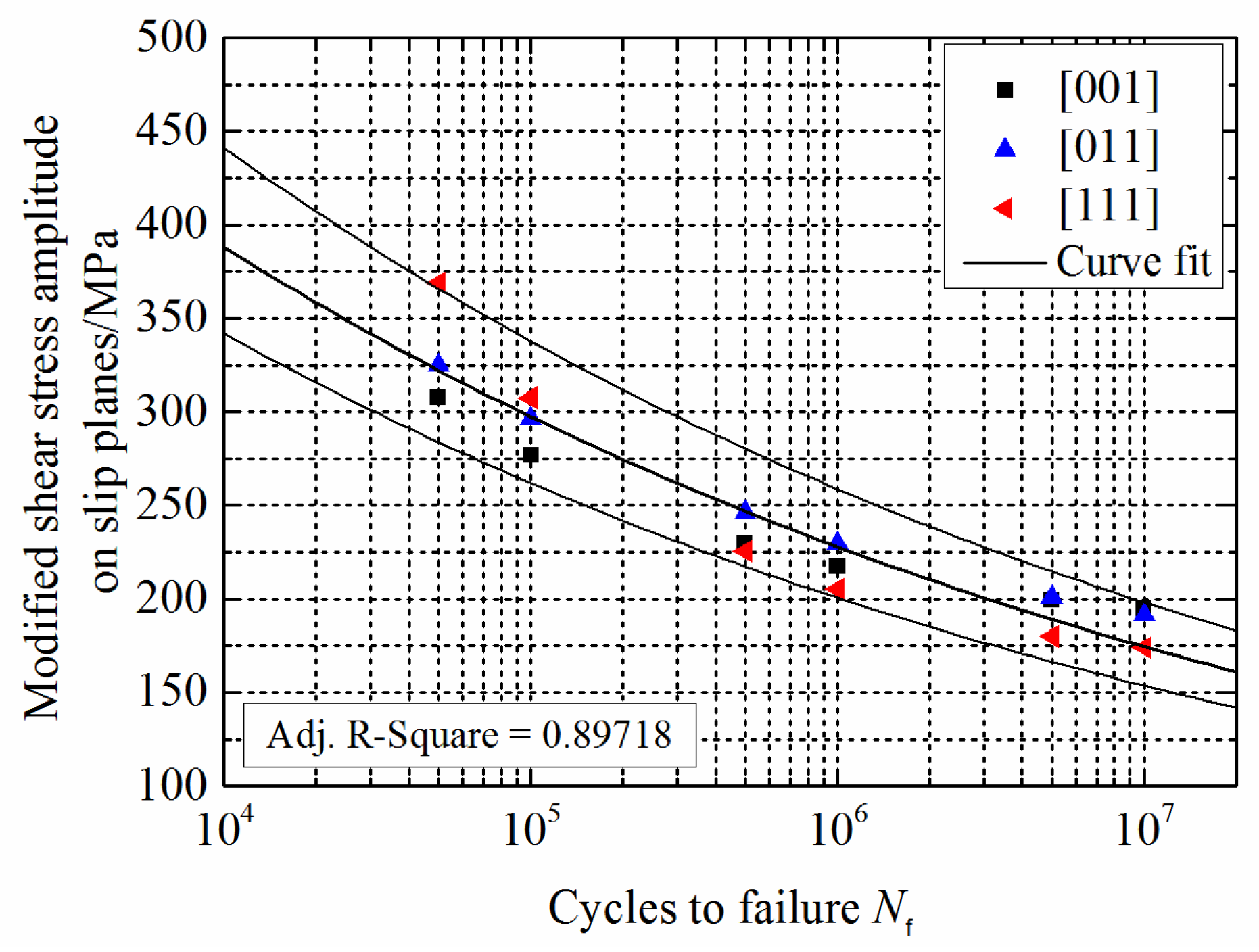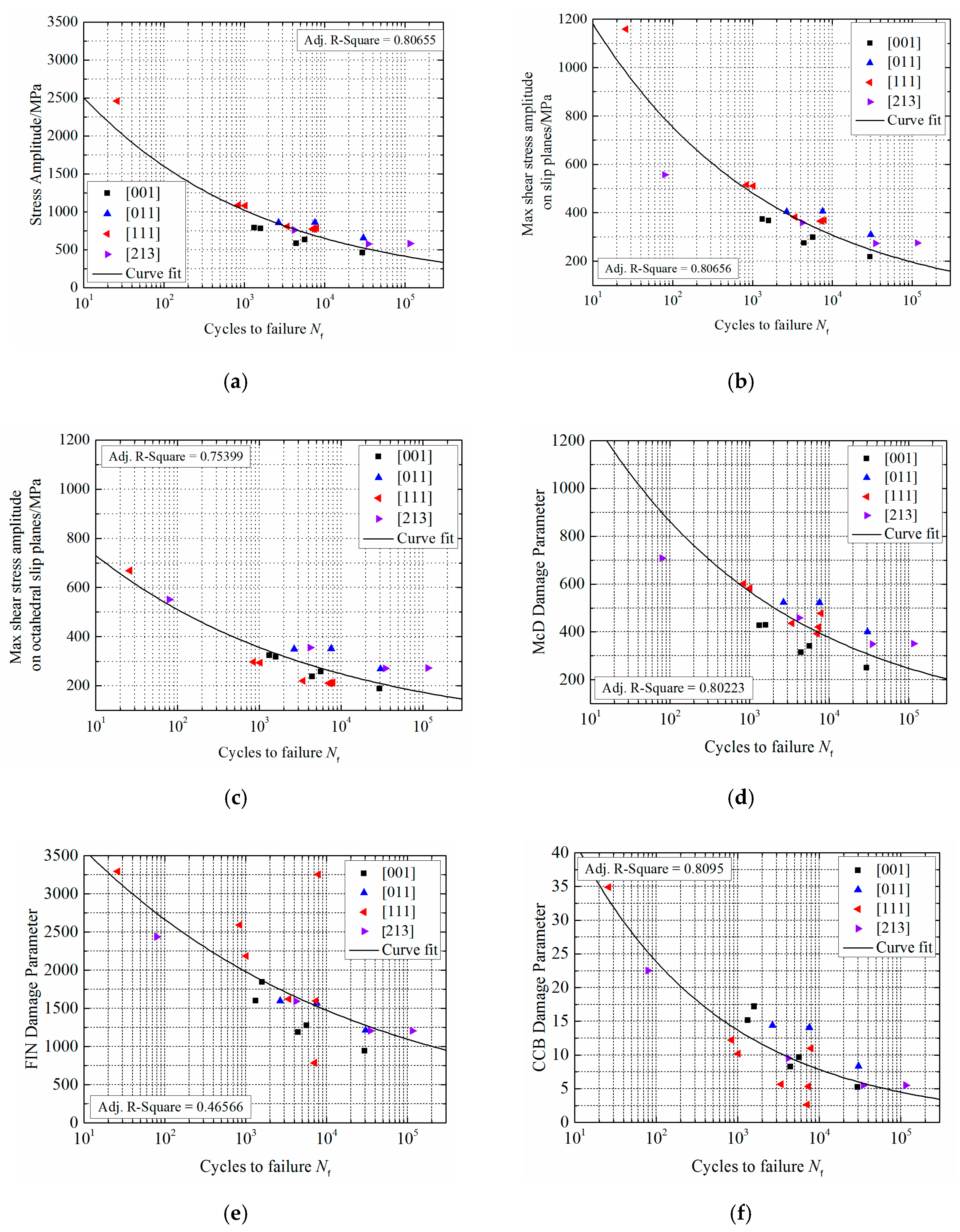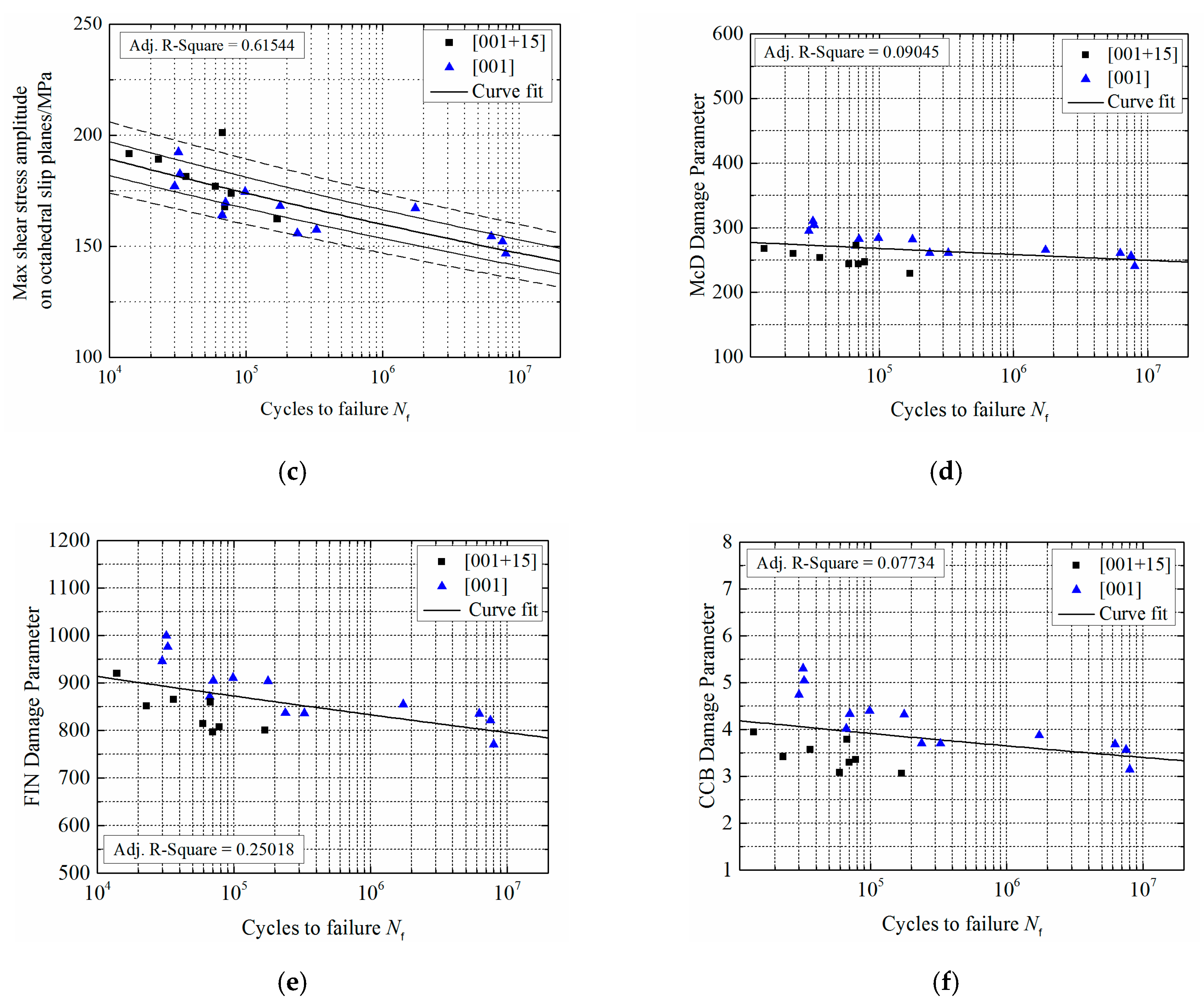A Fatigue Life Prediction Model Based on Modified Resolved Shear Stress for Nickel-Based Single Crystal Superalloys
Abstract
:1. Introduction
2. Methods
2.1. Elastic Stress and Strain Calculation of Nickel-Based Single Crystal
2.2. Nickel-Based Single Crystal Resolved Shear Stress and Resolved Shear Strain
2.3. Nickel-Based Single Crystal Fatigue Life Prediction Model
2.4. Modified Life Prediction Model
3. Results
3.1. High Cycle Fatigue Life Prediction for DD6 Material
3.2. Low Cycle Fatigue Life Prediction for PWA1480 Material
3.3. Fatigue Life Prediction of PWA1484 Material
4. Discussion
5. Conclusions
- For the high cyclic fatigue experiments for DD6 material at 700 °C and 800 °C with a stress ratio of −1 and the low cyclic fatigue experiments for PWA1480 material at different strain ratios at 648 °C, several classical nickel-based single crystal fatigue life prediction models were compared. The fatigue life prediction model with stress amplitude as the damage parameter, the fatigue life prediction model considering maximum resolved shear stress of the 30 slip directions as the damage parameter, the McD model, and the modified maximum resolved shear stress amplitude fatigue life prediction proposed in this paper were observed to have higher accuracy.
- For fatigue data obtained for PWA1484 material at 593 °C with a stress ratio of −1, the fatigue life prediction model proposed in this paper and the model considering maximum resolved shear stress of the primary octahedral slip system as the damage parameter had better prediction results. At lower temperatures, the model considering maximum resolved shear stress of the primary octahedral slip system as the damage parameter has greater engineering application prospects.
- Fatigue life prediction models with strain as the damage parameter have poor prediction accuracy.
- By comparing the aforementioned nickel-based single crystal fatigue life prediction models, for nickel-based single crystals at higher temperature, the proposed method and the fatigue life model with stress amplitude directly as the damage parameter have higher prediction accuracy and hence greater engineering application value.
Author Contributions
Funding
Conflicts of Interest
Nomenclature
| a | Fatigue strength coefficient |
| b | Fatigue strength exponent |
| A, B | Transformation matrix |
| C | Flexibility matrix |
| D | Elasticity matrix |
| E | Young’s modulus |
| G | Shear modulus |
| li, mi, ni | Cosines of the angle between the material coordinate system and the calculation coordinate system |
| lj | Firection cosines between the old and new coordinate systems |
| m(a) | Sliding direction of the αth slip system |
| n(a) | Normal direction of the plane of the αth slip system |
| M1 | Maximum value of the Schmid factor |
| M2 | Median value of the Schmid factor |
| Nf | Number of cycles to failure |
| ε | Strain tensor |
| Δεs,oct_prim | Maximum resolved shear strain range (the primary octahedral slip system) |
| Δεn | Normal strain corresponding to the resolved shear strain |
| Δεs | Maximum resolved shear strain range |
| υ | Poisson’s ratio |
| σ | Stress tensor |
| σmax | Maximum normal stress |
| τmax | Maximum shear stress |
| Δτmax | Maximum shear stress range |
| Δτ | Maximum resolved shear stress range |
| τ(a) | Resolved shear stress of the αth slip system |
| Δτs,oct_prim | Maximum resolved shear stress range (the primary octahedral slip system) |
| Δτoct_sec | Maximum resolved shear stress range (the secondary octahedral slip system) |
| Δτcub | Maximum resolved shear stress range (the cubic octahedral slip system) |
References
- Palmert, F.; Moverare, J.; Gustafsson, D.; Busse, C. Fatigue crack growth behaviour of an alternative single crystal nickel base superalloy. Int. J. Fatigue 2018, 109, 166–181. [Google Scholar] [CrossRef]
- He, Z.W.; Zhang, Y.Y.; Qiu, W.H.; Shi, H.-J.; Gu, J. Temperature effect on the low cycle fatigue behavior of a directionally solidified nickel-base superalloy. Mater. Sci. Eng. A 2016, 676, 246–252. [Google Scholar] [CrossRef]
- Ma, X.F.; Shi, H.J.; Gu, J.L.; Wang, Z.; Harders, H.; Malow, T. Temperature effect on low-cycle fatigue behavior of nickel-based single crystalline superalloy. Acta Mech. Solida Sin. 2008, 21, 289–297. [Google Scholar] [CrossRef]
- Zhang, Y.Y.; Shi, H.J.; Gu, J.L.; Li, C.; Kadau, K.; Luesebrink, O. Crystallographic analysis for fatigue small crack growth behaviors of a nickel-based single crystal by in situ SEM observation. Theor. Appl. Fract. Mech. 2014, 69, 80–89. [Google Scholar] [CrossRef]
- Wahi, R.P.; Auerswald, J.; Mukherji, D.; Dudka, A.; Fecht, H.-J.; Chen, W. Damage mechanisms of single and polycrystalline nickel base superalloys SC16 and IN738LC under high temperature LCF loading. Int. J. Fatigue 1997, 19, 89–94. [Google Scholar] [CrossRef]
- Li, P.; Li, Q.Q.; Jin, T.; Zhou, Y.Z.; Li, J.G.; Sun, X.F.; Zhang, Z.F. Comparison of low-cycle fatigue behaviors between two nickel-based single-crystal superalloys. Int. J. Fatigue 2014, 63, 137–144. [Google Scholar] [CrossRef]
- Wang, J.J.; Guo, W.G.; Su, Y.; Zhou, P.; Yuan, K. Anomalous Behaviors of a single-crystal nickel-base superalloy over a wide range of temperatures and strain rates. Mech. Mater. 2016, 94, 79–90. [Google Scholar] [CrossRef]
- Li, S.X.; Smith, D.J. Development of an anisotropic constitutive model for single-crystal superalloy for combined fatigue and creep loading. Int. J. Mech. Sci. 1998, 40, 937–948. [Google Scholar] [CrossRef]
- Sabnis, P.A.; Mazière, M.; Forest, S.; Arakere, N.K.; Ebrahimi, F. Effect of secondary orientation on notch-tip plasticity in superalloy single crystals. Int. J. Plasticity 2012, 28, 102–123. [Google Scholar] [CrossRef]
- Sabnis, P.A.; Fores, S.; Arakere, N.K.; Yastrebova, V.A. Crystal plasticity analysis of cylindrical indentation on a Ni-base single crystal superalloy. Int. J. Plasticity 2013, 51, 200–217. [Google Scholar] [CrossRef]
- Arakere, N.K.; Siddiqui, S.; Magnan, S.; Ferroro, L. Investigation of three-dimensional stress fields and slip systems for FCC single crystal superalloy notched specimens. J. Eng. Gas Turbines Power 2005, 127, 629–637. [Google Scholar] [CrossRef]
- Gong, B.; Wang, Z.R.; Wang, Z.G. Cyclic Deformation behavior and dislocation structures of [001] copper single crystals—I Cyclic stress-strain response and surface feature. Acta Mater. 1997, 45, 1365–1377. [Google Scholar] [CrossRef]
- Lekhnitskii, S.G. Theory of Elasticity of an Anisotropic Elastic Body; Society for Industrial and Applied Mathematics: Philadelphia, PA, USA, 1967; pp. 1–8. [Google Scholar]
- Arakere, N.K.; Swanson, G. Effect of crystal orientation on fatigue failure of single crystal nickel base turbine blade superalloys. J. Eng. Gas Turbines Power 2002, 124, 161–176. [Google Scholar] [CrossRef]
- Naik, R.A.; DeLuca, D.P.; Shah, D.M. Critical plane fatigue modeling and characterization of single crystal nickel superalloys. J. Eng. Gas Turbines Power 2004, 126, 391–400. [Google Scholar] [CrossRef]
- Arakere, N.K. High-temperature fatigue properties of single crystal superalloys in air and hydrogen. J. Eng. Gas Turbines Power 2004, 126, 590–603. [Google Scholar] [CrossRef]
- Editorial Board of Material Data Sheet of Aircraft Engine Design. Material Manual for Aero Engine Design, 4th ed.; Aviation Industry Press: Beijing, China, 2010; pp. 250–322. [Google Scholar]
- Wen, Z.X.; Pei, H.Q.; Yang, H.; Wu, Y.; Yue, Z. A Combined CP theory and TCD for predicting fatigue lifetime in single-crystal superalloy plates with film cooling holes. Int. J. Fatigue 2018, 111, 243–255. [Google Scholar] [CrossRef]
- Dong, C.L.; Yu, H.C.; Li, Y.; Yang, X.; Shi, D. Life modeling of anisotropic fatigue behavior for a single crystal nickel-base superalloy. Int. J. Fatigue 2014, 61, 21–27. [Google Scholar] [CrossRef]
- Kanda, M.; Sakane, M.; Ohnami, M.; Hasebe, T. High temperature multiaxial low cycle fatigue of CMSX-2 Ni-base single crystal superalloy. J. Eng. Mater. Technol. 1997, 119, 153–160. [Google Scholar] [CrossRef]
- Wei, D.S.; Wang, J.L.; Wang, Y.R.; Zhong, B. Experimental and numerical investigation of the creep behaviour of Ni-based superalloy GH4169 under varying loading. Fatigue Fract. Eng. Mater. Struct. 2018, 41, 1146–1158. [Google Scholar] [CrossRef]
- Zhong, B.; Wang, Y.R.; Wei, D.S.; Wang, J. A New life prediction model for multiaxial fatigue under proportional and non-proportional loading paths based on the Pi-plane projection. Int. J. Fatigue 2017, 102, 241–251. [Google Scholar] [CrossRef]
- Zhong, B.; Wang, Y.R.; Wei, D.S.; Zhang, K.; Wang, J. Multiaxial fatigue life prediction for powder metallurgy superalloy FGH96 based on stress gradient effect. Int. J. Fatigue 2018, 109, 26–36. [Google Scholar] [CrossRef]
- Dowling, N.E.; Calhoun, C.A.; Arcari, A. Mean stress effects in stress-life fatigue and the walker equation. Fatigue Fract. Eng. Mater. Struct. 2009, 32, 163–179. [Google Scholar] [CrossRef]
- Jiang, R.; Bull, D.; Evangelou, A.; Harte, A.; Pierron, F.; Sinclair, L.; Preuss, M.; Hu, X.T.; Reed, P.A.S. Strain accumulation and fatigue crack initiation at pores and carbides in a SX superalloy at room temperature: X-ray computed tomography, tabulated data and modelling datasets. Int. J. Fatigue 2018, 114, 22–33. [Google Scholar] [CrossRef]
- Lukáš, P.; Kunz, L.; Svoboda, M. High-temperature ultra-high cycle fatigue damage of notched single crystal superalloys at high mean stresses. Int. J. Fatigue 2005, 27, 1535–1540. [Google Scholar] [CrossRef]












| Direction Cosines | Material CSYS | ||
|---|---|---|---|
| x | y | z | |
| x’ | l1 | m1 | n1 |
| y’ | l2 | m2 | n2 |
| z’ | l3 | m3 | n3 |
| Direction Cosines | x | y | z |
|---|---|---|---|
| x’ | l11 | l12 | l13 |
| y’ | l21 | l22 | l23 |
| z’ | l31 | l32 | l33 |
| (1) Maximum resolved shear stress amplitude | |
| (2) Maximum resolved shear stress amplitude (primary octahedral slip system) | |
| (3) Maximum resolved shear strain amplitude | |
| (4) Maximum resolved shear strain amplitude (primary octahedral slip system) | |
| (5) Maximum shear stress range | |
| (6) Chu-Conle-Bonnen (CCB) model | |
| (7) Findley (Fin) model | |
| (8) McDiarmid (McD) model |
| Material Properties | DD6 (700 °C) | DD6 (800 °C) | PWA1480 (648 °C) | PWA1484 (593 °C) |
|---|---|---|---|---|
| E/GPa | 107.0 | 102.2 | 106.2 | 108.2 |
| G/GPa | 100.2 | 85.3 | 108.3 | 109.8 |
| ν | 0.3740 | 0.3797 | 0.4009 | 0.3995 |
| (1) | With maximum resolved shear stress amplitude of the 30 slip systems as the damage parameter, all of the fatigue life prediction results are good. |
| (2) | With maximum resolved shear stress amplitude of the primary octahedral slip system as the damage parameter, all of the fatigue life prediction results are worse. |
| (3) , (4) | Models with resolved shear strain amplitude as the damage parameter generally have poor prediction results for nickel-based single crystal materials. |
| (5) | The fatigue life prediction model with stress amplitude or maximum shear stress as the damage parameter has a higher life prediction accuracy. |
| (6) CCB | Life prediction results obtained by using the CCB model for PWA1480 low cycle fatigue data are better, while the life prediction results of the CCB model for DD6 high cycle fatigue data are worse. |
| (7) Fin | Life prediction results for DD6 high cycle fatigue data obtained using the Fin model are better, while those for PWA1480 low cycle fatigue data obtained using the Fin model are worse. |
| (8) McD | The McD model has a higher life prediction accuracy. |
| (9) | The nickel-based single crystal fatigue life prediction model based on modified resolved shear stress amplitude, which has been proposed in this paper, has higher life prediction accuracy. |
© 2019 by the authors. Licensee MDPI, Basel, Switzerland. This article is an open access article distributed under the terms and conditions of the Creative Commons Attribution (CC BY) license (http://creativecommons.org/licenses/by/4.0/).
Share and Cite
Wang, J.; Wei, D.; Wang, Y.; Jiang, X. A Fatigue Life Prediction Model Based on Modified Resolved Shear Stress for Nickel-Based Single Crystal Superalloys. Metals 2019, 9, 180. https://doi.org/10.3390/met9020180
Wang J, Wei D, Wang Y, Jiang X. A Fatigue Life Prediction Model Based on Modified Resolved Shear Stress for Nickel-Based Single Crystal Superalloys. Metals. 2019; 9(2):180. https://doi.org/10.3390/met9020180
Chicago/Turabian StyleWang, Jialiang, Dasheng Wei, Yanrong Wang, and Xianghua Jiang. 2019. "A Fatigue Life Prediction Model Based on Modified Resolved Shear Stress for Nickel-Based Single Crystal Superalloys" Metals 9, no. 2: 180. https://doi.org/10.3390/met9020180





